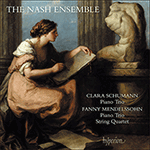
Welcome to Hyperion Records, a British classical label devoted to presenting high-quality recordings of music of all styles and from all periods from the twelfth century to the twenty-first.
Hyperion offers both CDs, and downloads in a number of formats. The site is also available in several languages.
Please use the dropdown buttons to set your preferred options, or use the checkbox to accept the defaults.

| The Nash Ensemble» More |
Mendelssohn’s trio opens tumultuously, almost ferociously; even when she introduces lyrical material, the underlying texture shimmers with tension and energy. Her extraordinary pianistic abilities are showcased in the demanding scalic and arpeggiated textures of the opening ‘allegro molto vivace’. The move to a major key is like the sun emerging from behind the clouds, but its respite is brief; in this performance this is angry music, phenomenally assured, richly textured, roaring and raging towards the close of the first movement. The chorale-like opening of the ‘andante espressivo’ leads into a stately waltz, elegant but suffused with yearning, before moving to a resigned, tranquil ending. The third movement, entitled ‘Lied’, draws on the world of the German folk-song, and is a slighter interlude before the rhapsodic solo-piano opening of the finale, which recalls Chopin in its elegant melancholy before moving into a polka-like texture replete with the same motoric energy that characterizes the first movement. The whole work dances towards a triumphant, ebullient end in D major.
from notes by Natasha Loges © 2020
Le trio de Fanny Mendelssohn commence tumultueusement, presque violemment; même lorsqu’elle introduit du matériel lyrique, la texture sous-jacente vibre de tension et d’énergie. Ses extraordinaires capacités pianistiques sont mises en valeur dans les textures ardues de gammes et arpèges de l’«allegro molto vivace» initial. Le passage en majeur est comparable au soleil émergeant derrière les nuages, mais son répit est de courte durée; dans cette exécution, c’est une musique enragée, assurée de manière phénoménale, aux textures riches, rugissant et tempêtant vers la conclusion du premier mouvement. Le début, dans le style d’un choral, de l’«andante espressivo» mène à une valse imposante, élégante mais imprégnée de désir ardent, avant de passer à une fin résignée et tranquille. Le troisième mouvement, intitulé «Lied», s’inspire de l’univers du chant traditionnel allemand et constitue un interlude plus léger avant le début rhapsodique du finale au piano seul, qui rappelle Chopin dans sa mélancolie élégante avant de passer à une texture de polka pleine de la même énergie motrice qui caractérise le premier mouvement. L’ensemble de cette œuvre danse vers une conclusion triomphale et exubérante en ré majeur.
extrait des notes rédigées par Natasha Loges © 2020
Français: Marie-Stella Pâris
Fanny Mendelssohns Trio beginnt stürmisch, fast wild; auch wenn sie lyrisches Material einführt, schimmert die Spannung und Energie der darunterliegenden Struktur noch durch. Ihre außergewöhnlichen pianistischen Fähigkeiten werden mit den anspruchsvollen Läufen und Arpeggien im „Allegro molto vivace“ demonstriert. Der Wechsel nach Dur wirkt wie die Sonne, die hinter den Wolken auftaucht, doch ist die Ruhepause nur von kurzer Dauer; in der hier vorliegenden Aufführung ist dies zornige Musik, äußerst souverän ausgeführt, reichhaltig strukturiert, wütend und tobend bis zum Ende des ersten Satzes. Der choralartige Beginn des „Andante espressivo“ führt zu einem stattlichen Walzer, elegant, aber voller Sehnsucht, bevor der Satz ein resigniertes, ruhiges Ende nimmt. Der dritte Satz trägt den Titel „Lied“ und bezieht sich auf das deutsche Volksliedrepertoire und stellt eine Art schlankes Zwischenspiel dar, bevor das Finale mit einer rhapsodischen, in ihrer eleganten Melancholie an Chopin erinnernden Passage für Klavier solo beginnt. Darauf folgt ein polkaähnlicher Satz mit einer ähnlichen motorischen Energie wie im ersten Satz. Das Werk tanzt einem triumphalen, überschwänglichen Ende in D-Dur entgegen.
aus dem Begleittext von Natasha Loges © 2020
Deutsch: Viola Scheffel
 Schumann (C) & Mendelssohn (Fanny): Piano Trios & String Quartet Schumann (C) & Mendelssohn (Fanny): Piano Trios & String QuartetA release which celebrates the talents and importance of the ‘other’ Mendelssohn and Schumann.» More |

